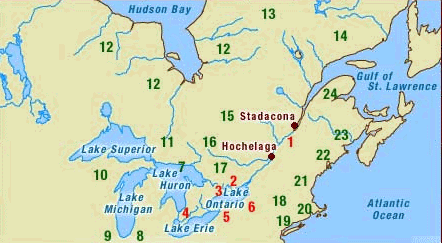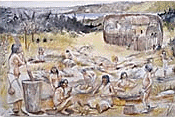The St. Lawrence Iroquoians: who are they?
During the era of Jacques Cartier's voyages, north-eastern North America was inhabited by a great many Amerindian nations, which differed from one another in terms of their ways of life, their political systems, their means of subsistence, their beliefs, and their languages. The multitude of Aboriginal languages can nevertheless be grouped into two major linguistic families: the Algonquian and Iroquoian which also reflect a cultural division.
Nations which spoke an Algonquian language occupied the greater portion of north-eastern North America. These groups of nomad hunters living in the boreal forest included the Innuat (Montagnais and Naskapi), the Atikameks, the Crees, the Algonkins (a specific nation, not to be confused with the Algonquian language family, which encompassed many nations), the Nipissings, the Ottawa and the Ojibways. A number of nations occupied the area comprised between the Appalachians and the Atlantic seaboard. The further south one went, the more these groups depended on agriculture. From north to south, these nations included the Micmacs, the Malecites, the numerous groups forming the Abenakis, the Mohicans, as well as several populous groups in what was to become New England, such as the Pequots, the Massachusetts and the Narragansetts. Finally, further to the west, in a region south of the Great Lakes and including the upper Mississippi Valley were other major nations which spoke an Algonquian language, for example the Illinois, the Miamis and the Menominis.
 Map of the Province of Québec showing the localisation of the 24 Amerindians nations.
Map of the Province of Québec showing the localisation of the 24 Amerindians nations.Approximate location of several Amerindian nations the time of Cartier's arrival:
(Map legend: red = Iroquoian nations and green = Algonquian nations)
About Iroquoia
In the very middle of this huge territory inhabited by member nations of the Algonquian linguistic family was a "foreign" enclave of peoples who spoke one of the Iroquoian languages. This unique group also went by the name of "Iroquoia" and was distinguished by a set of cultural features unlike those of the Algonquian groups. The territory covered by Iroquoia included the eastern portion of the Great Lakes area, the St. Lawrence Valley, and the entire northern portion of present-day New York State. Member nations were the Hurons, the Petuns, the League of Five Nations (the Senecas, the Cayugas, the Onondagas, the Oneidas, and the Mohawks), the Neutrals, the Eries, not to mention the St. Lawrence Iroquoians.
 An Iroquian village
An Iroquian village© Videanthrop inc., Montréal
In addition to being related linguistically, the Iroquoian nations shared several other characteristics. They lived in semi-permanent villages occasionally surrounded by log palisades, and dwelled in the famous, multifamily longhouses. Theirs was a mixed economy, in which they drew their subsistence from growing corn, squash and beans, hunting, fishing, and gathering. These nations also had in common a matrilineal, clan-based social organization, and a political system sufficiently structured as to permit confederation at times. Most of them engaged in guerrilla warfare, grew and used tobacco, and produced pottery vessels.
The St. Lawrence Iroquoians belonged to the Iroquoian cultural world. Their territory extended along the St. Lawrence from Lake Ontario to the estuary. They were, for this reason, the easternmost and northernmost group in Iroquoia. Living on the fringes of Iroquoia meant that the easternmost members of the St. Lawrence Iroquoians, who lived in the vicinity of present-day Québec, bore the imprint of their region. They are among the less well-known of the Iroquois nations, for having abandoned the St. Lawrence Valley sometime after the arrival of Jacques Cartier. As a result, the narratives of the French navigator are about the only remaining eyewitness descriptions of this group. Archaeology has proved to be an indispensable source of information for understanding the St. Lawrence Iroquoian culture.
Related links
- Date modified :